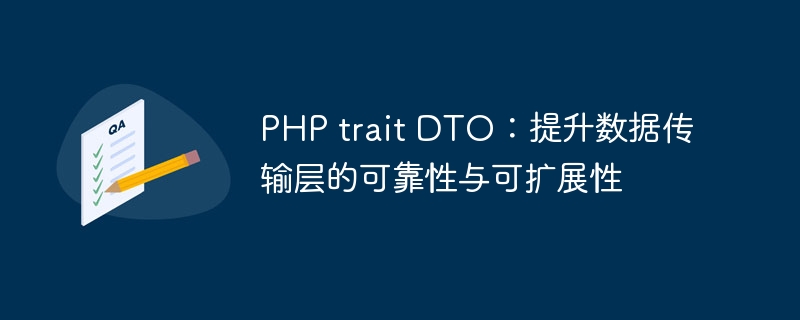

PHP trait DTO: Improve the reliability and scalability of the data transmission layer, specific code examples are required
Overview:
In a typical PHP application , data transmission is a very common operation. Normally, we use arrays, objects, or associative arrays to transfer data. However, this method of transmission is not always reliable and scalable.
In order to solve this problem, we can use PHP traits and DTO (Data Transfer Object) design patterns to improve the reliability and scalability of the data transfer layer. This article will introduce what traits and DTOs are, and give specific PHP code examples.
What is trait?
In PHP, trait is a code reuse mechanism that can share methods between multiple classes. A trait is similar to a class, except that it cannot be instantiated. Traits can be used by multiple classes, thus avoiding the problem of multiple inheritance.
What is DTO?
DTO is the abbreviation of Data Transfer Object, which means data transfer object. A DTO is a data structure that is used to transfer data, usually as method parameters or return values.
Why use traits and DTOs to improve the reliability and scalability of the data transmission layer?
The main benefit of using traits and DTOs is to separate the responsibilities of data transmission, making the code clearer, maintainable and testable. In addition, trait and DTO design patterns can provide higher flexibility and scalability.
Specific code example:
The following is a code example using traits and DTO to show how to improve the reliability and scalability of the data transmission layer.
$maxLength) {
throw new Exception("$field的长度必须在$minLength到$maxLength之间");
}
}
}
class UserDTO {
use ValidationTrait;
private $username;
private $email;
public function __construct($username, $email) {
$this->validateRequired('用户名', $username);
$this->validateLength('用户名', $username, 6, 20);
$this->validateRequired('邮箱', $email);
$this->validateLength('邮箱', $email, 6, 50);
$this->username = $username;
$this->email = $email;
}
public function getUsername() {
return $this->username;
}
public function getEmail() {
return $this->email;
}
}
// 使用UserDTO类来创建用户对象
$user = new UserDTO('john123', '[email protected]');
// 获取用户对象的属性值
$username = $user->getUsername();
$email = $user->getEmail();
// 输出用户对象的属性值
echo "用户名: $username" . PHP_EOL;
echo "邮箱: $email" . PHP_EOL;
?>In the above example, we defined a UserDTO class that uses the ValidationTrait trait. The constructor of the UserDTO class uses the verification method defined in the trait to verify the incoming parameters and assigns legal data to the private properties of the class. By using traits and DTOs, we can separate the logic of data validation from the UserDTO class, making the code clearer and maintainable.
Summary:
By using PHP's traits and DTO design patterns, the reliability and scalability of the data transmission layer can be improved. Using traits can separate code reuse and data verification logic, making the code clearer and maintainable. Using DTO can define the structure of data transmission, making the code more readable and maintainable. The above demonstrates specific code examples of how to use traits and DTOs, aiming to help developers better understand and apply this design pattern.
The above is the detailed content of PHP trait DTO: Improve the reliability and scalability of the data transfer layer. For more information, please follow other related articles on the PHP Chinese website!